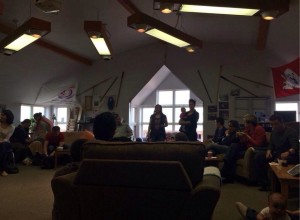Right now there are discussions about the Nunavut land use plan. It is a critical discussion on how we see our relationship with the land. The recent report released by Minister’s Special Representative, Mary Simon called “A new Shared Arctic Leadership Model” challenged the federal government to re-imagine conservation through Indigenous Protected Areas. We are at a defining time with our relationship with our environment.
For millennia, Inuit have had a spiritual and close connection with nuna (land), tariuq (sea) and sila (a complex word often simplified to weather force or sky); a relationship of reciprocity and reverence. On the day Nunavut was created, a ceremony was held where three respected elders gave three pieces of paper to three youth, each containing a principle; to protect the land, sea and sky. These elders were told that Nunavut would operate on those core Inuit principles from then on. But since then, all three elders have expressed disappointment and a feeling of betrayal that the leaders of Nunavut have not kept these promises.
Respected Elder late Aupilaarjuk was one of those three elders, and he stated “… In order to survive from the land, you have to protect it. The land is so important for us to survive and live on; that’s why we treat it as part of ourselves” (Uqalurait, p. 118).
The individual and collective Inuit relationship with the land started to change with Canada’s attempt to assimilate the Eskimo and colonize the lands and waters they depend on for life. A generation of young children were taken away to distant lands or sent to federal day schools and immersed in a foreign educational regimen that chipped away at the close bonds to family, community, nuna, tariuq and sila. Efforts were made at stripping away their mother tongue, with the message was that learning and adopting the qallunaat way of living would lead to a good future. Further actions have been taken so as to extract Inuit from the land and to create greater dependence on outside sources. Dogs, which were means for livelihood, were slaughtered. Employment in municipal services or in the mining industry were encouraged as the path to economic prosperity for the modern Inuk. These ideas still largely remain today.
Through the Nunavut Land Claim Agreement (NLCA), Inuit have jurisdiction over 18% of the Nunavut settlement area. The remainder legally became Canada’s to manage, with clauses ceding ultimate responsibility and authority to the state. A number of Designated Inuit Organizations were established to oversee various regulatory regimes, with Federal, Territorial and Inuit partners each appointing directors to the commissions, panels, tribunals, committees and boards. Without a devolution agreement in place between the Federal Government and the Government of Nunavut, the Crown maintains a significant controlling stake of “lands belonging to her majesty”, as well as an active hand in the small parcels of lands under shared management regimes.
All land management regimes in the territory mirror the directives of the Federal government, including oversight of exploration and mining. Once exploration is permitted, those with permits then have a right to develop the land for its potential. This process leaves very little room for ‘free, prior, informed consent’ to a project as required by The United Nations Declaration on the Rights of Indigenous Peoples.
There are also looming articles that can limit Inuit access to lands. One such Article is 5.7.17 that speaks of lands not subject to right of access for Inuit. Potentially this list of lands could become inaccessible to Inuit for “military” or ”financial” reasons. This gives broad, unilateral decision-making authority to the Federal government.
In the preamble of the NLCA it states it has the following objectives:
- “provide certainty and clarity of rights to ownership and use of lands and resources, and of rights for Inuit to participate in decision-making concerning use, management and conservation of land, water and resources, including offshore;
- provide Inuit with wildlife harvesting rights and rights to participate in decision making concerning wildlife harvesting;
- to provide Inuit with financial compensation and means of participating in economic opportunities;
- to encourage self-reliance and cultural and social well-being of Inuit.”
Further, Article 17 of the claim states: “The primary purpose of Inuit Owned Lands shall be to provide Inuit with rights in land that promote economic self-sufficiency of Inuit through time, in a manner consistent with Inuit social and cultural needs and aspirations.” This article goes on to describe areas including areas of value for wildlife harvesting, areas of significant biological diversity or of value for conservation purposes, areas of value for sport camps or other tourist opportunities as well as areas of commercial and mineral potential, including areas of value for operations of development of non-renewable resources. Lands were picked to have more control over lands, especially control over those that have mineral potential so that Inuit would have more say over what happens to the lands including protection for wildlife and an important areas.
It is clear the NLCA is about balancing interests. It allows for and supports extractive industries, but also seeks to protect and maintain cultural and social integrity of Inuit and the right to use of lands for harvesting, conservation and renewable resource economies.
There is a push and pull between our historic and contemporary relationship with the land, a product of our struggle with internalized colonialism and the policies and practices of the various moving parts of the system. Have we adopted ideas of dominion over land and decided that land should be owned and exploited?
Traditionally, Inuit would identify as belonging to a particular area i.e. Aivilingmiut, Natsilirmiut, Uqqurmiut meaning ‘of that’ region. More recently, much of the discourse involves implied ownership over particular areas i.e. Nunavut. What happened to Inuit values, of being part of the land, and the refrain that what we do to the land we do to ourselves? Have core Inuit ideologies changed from belonging to the land, to the land belonging to people, consequently corporations and governments?
Recently, the draft Nunavut Land Use plan was released. It proposes a 15% of lands in Nunavut be designated protected areas, 4% special management areas, and 81% as mixed, and be open to mining.
Last month Inuit organizations in Nunavut issued responses arguing there are too many proposed protected areas in the draft plan, as it stands, stating this will interfere with exploitation of minerals. They further state it is “not compatible with Inuit goals and objectives” and “in most cases, subsurface Inuit owned lands were selected to support the exercise of mineral rights. Nunavut Tunngavik Inc. is of the view that, as a rule, the proposed NPC designations should not detract from the development of mineral rights on subsurface IOLs.”
Based on the decisions and statements being made by Inuit organizations today, it makes it appear as though there is direction coming from the community and region that their priority is with extractive industries and non-renewable economic development activities, when in fact it may not be so. That the conservation, preservation and use of nuna, tariuq and sila for harvesting or other renewable economic development purposes are dismissed as minimal consideration. Attempts to find a suitable balance have been found by our governing institutions too restrictive and pose a threat to economic development.
Despite expressions of concern from individuals and local groups, it seems our Inuit organizations are walking further away from Inuit cultural values and cementing the colonial values in our lives. In many ways, mining has become a significant part of the Territorial government’s agenda. This is evident through the criticism by territorial government on the federal governments ban on oil exploration. Those with community input obligations or opportunity such as Hunters and Trappers organizations and municipalities do not have the resources for policy or legal capacity to engage fully.
Our Inuit organizations’ interpretation of the NLCA is disappointing and strays from the original intent of protecting cultural rights. Surely Inuit expected – and continue to expect – greater economic prosperity, but certainly not at the cost of our deep rooted connection with nuna and sila. Clearly, as stated in the agreement, areas of value for renewable resource reasons, for harvesting and conservation of the land are expressly recognized for their value and form an integral part of the legal agreement between Inuit and the Crown.
If we were to protect a mere 15% of our land, one can ask if the dream of Nunavut was intended to amount to this. Given climate change and other internal and external pressures, can the generations to come after us afford such an approach to mineral development to such an extensive land mass? Is there a lower threshold of conservation in any other Indigenous or Canadian jurisdiction in Canada?
When Inuit communities and leaders promote and pursue mining at all costs, it reflects on all of us. Prioritizing short term economic gain assumes the land is only for this current generation.
Not only is this approach straying dangerously further from Inuit values, it also discredits Inuit on issues of climate change and environmental stewardship. How can we be taken seriously on Arctic environment policy when we promote mining free-for-all? How can we, on one hand, say we want to damage the environment, and on the other hand ask for help to deal with the affects of climate change? It does not jive.
Inuit have gone through rapid change and have faced massive disruption in their lives. In fifty years Inuit have gone from being completely self-sufficient, proud people to largely being wards of the state. From a people intimately concerned for the health of the land, waters and all life dependent on it and seeking to support a balance in nature – to a society seemingly seeking economic prosperity by exploiting lands above all else.
We have many men in jail and many, many of our young people taking their lives by their own hands. We have seen that continuing to divert away from Inuit values damages our people’s self-confidence and sense of self-worth. Fast money and short term jobs only compound the many social ills affecting our communities and serve to further sever Inuit from our cultural values. It simply is not sustainable on all fronts.
These are symptoms of acculturation, being stripped of culture and identity. The answer to deal with acculturation is re-culturation, re-vitalization of Inuit values. Not to propose to further drift away. Rather than accepting mining as our sole economic saviour, we must encourage and support further development of economies that start from the basis of the stewardship of nuna and sila. Some examples are fisheries, seal skin market, and cultural industry. These do not need to be massive unsustainable endeavours.
Who of us have not felt the healing power of the land? Felt nourished to the soul by hunted meat? The draw to center as we breathe and take in the air and sounds of our beautiful land? As an Elder stated in an interview “Nuna is lovingly nurturing to me if I am loving to it. If I look after it well, I will inevitably become a loving person” (K. Williamson, p.48)
We must be responsible when making decisions about nuna and sila. It is imperative. Any look at recent and historic non-renewable resource rushes demonstrate the risks and dangers of destruction of lands, wildlife, and a way of life.
“From our ancestors we were always told to respect the land… because if you do that, the land will give you abundant wildlife. What you do to the land, the land will do to you.” Mariano Aupilaarjuk (Uqalurait, p. 119).
It is our children and their children that will have to contend with our legacy.


